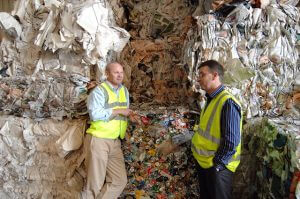Tuesday 10 October, 2017
Waste as a Resource
Taken from: Irish Engineers Journal Supplement, 1970, p40-46
 Bord na Móna’s resource recovery business is at the forefront of addressing waste management in a way that makes environmental and commercial sense.
Bord na Móna’s resource recovery business is at the forefront of addressing waste management in a way that makes environmental and commercial sense.
From household waste to a company’s waste management chain to treating competitors’ waste, AES can manage it all, using the latest technology. With 6,000 commercial customers and 60,000 domestic customers, AES’s five waste transfer centres handle about 300,000 tonnes of waste per year.
“At the moment, we keep more than half of that waste out of landfill,” said Tom Walsh, head of Bord na Móna’s Resource Recovery business. “We have a network of fi ve waste transfer centres that have mechanical size separation technologies that allows us to sort through waste streams and extract those that have a value beyond landfill. At our Tullamore plant, we use infrared identification of waste types in order to provide more sophisticated separation. Here, we take the contents of the dry recycling bin and split them into their specific fractions and sell them on the global recovered cardboard and plastics markets. In Navan, we operate a 6,000 tonne biostabilisation unit that takes in bio-degradable waste and takes the harm out of it, in environmental terms.”
Over the next four years, Bord na Móna plans to increase that 50% of landfill diversion up to 80%, so that only 20% of material will go to landfill. And much of that process will rely on investment in specific technologies.
“We have planning permission at our Drehid landfill site in Co. Kildare for a 25,000 tonne brown bin waste composting facility that would be the largest of its kind in the country,” said Tom, an accountant by trade with a background in logistics industries. “It will convert the contents of the organic brown bin into a material that’s capable of being introduced into our growing media products in Bord na Móna’s horticulture business. That will be a €7m investment in technology and we expect to have that system up and running early next year.
“We also expect to have in place a mechanical and biological treatment (MBT) plant in Drehid. Essentially, this is a series of technologies linked together to mechanically separate the waste and bio-treat it either through composing or anaerobic digestion. This type of technology is a key part of our landfill-avoidance agenda.”
Technology will also be applied at the source of the waste, namely on the customers’ bins. “We’ve started rolling out Radio Frequency Identification (RFID) chips on the bins of our domestic and commercial customers. That allows us to monitor what’s happening with that bin, see on GPS where it is, understand how many times it gets lifted, how much weight comes out if it. It also allows us to plan far better our route network and also to have more flexibility in terms of how we invoice our customers. This is a pre-requisite to pay-by-weight, so we’re putting a lot of effort into that technology and also developing our customer services infrastructure.”
The irony is that the customer will most likely never know the effort and technology used in better managing their waste. But by segregating the waste efficiently in the bin at the back of their house or factory, that customer is a vital cog in helping the waste industry to make that waste a valuable resource.
How Resource Recovery ties in with the Bord na Móna family
As well as using the planned brown bin waste compost in the horticulture division’s growing media products, Resource Recovery has a logistics network that allows them to lay their hands on the type of green waste, including industrial green waste and horticultural green waste that the composting business at Kilberry, Co. Kildare requires for its feedstock. “A good example is that recently, together with our colleagues in Horticulture, we devised a solution for Glanbia that allows for composting of their dairy sludges at Kilberry Co. Kildare rather than land-spreading that material.”
In terms of the Energy division, at it widest scale, most waste has energy potential. “With the guys in Energy, we’re putting together a proposal to seek EPA approval to allow us to create a biomass product from waste timber,” said Tom. “We end up with about 10,000 tonnes of waste timber per year and rather than shredding that and it ending up as landfill cover, we want to segregate the clean timber and send it to Edenderry power plant as fuel.
“Equally, in about two years’ time, the landfill at Drehid will be generating sufficient quantities of landfill gas that, instead of simply flaring off the gas, we will be able to capture that energy through on-site generation and connection to the grid.”
Did You Know?
- Ireland exports 1.5m tonnes of recycled waste every year (mostly to China)
- Total household and commercial waste collected increased from 854,866 tonnes in 1984 to 3.1m tonnes in 2006
- In 2007, the quantity of municipal waste recycled increased by 3.6%, household waste by 8% and packaging waste by 14%.
- In 2007, 26% of household waste was recycled. While satisfactory, there remains considerable distance to reduce the land-filling of household waste to 50% by 2013.
- In 2007, 64% of packaging waste was recycled, diverting more than 55,000 tonnes of packaging from landfill. This exceeds the EU recycling target of 60% by 2011.